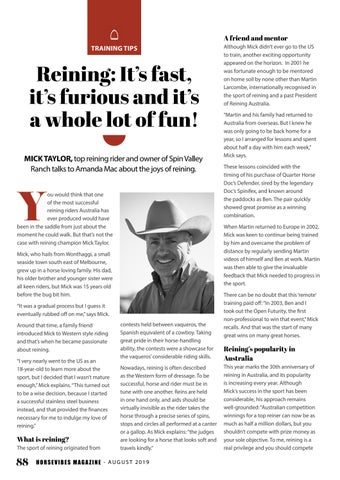A friend and mentor TRAINING TIPS
Reining: It’s fast, it’s furious and it’s a whole lot of fun! MICK TAYLOR, top reining rider and owner of Spin Valley Ranch talks to Amanda Mac about the joys of reining.
Y
ou would think that one of the most successful reining riders Australia has ever produced would have been in the saddle from just about the moment he could walk. But that’s not the case with reining champion Mick Taylor.
“It was a gradual process but I guess it eventually rubbed off on me,” says Mick.
“I very nearly went to the US as an 18-year-old to learn more about the sport, but I decided that I wasn’t mature enough,” Mick explains. “This turned out to be a wise decision, because I started a successful stainless steel business instead, and that provided the finances necessary for me to indulge my love of reining.”
What is reining? The sport of reining originated from
88
“Martin and his family had returned to Australia from overseas. But I knew he was only going to be back home for a year, so I arranged for lessons and spent about half a day with him each week,” Mick says. These lessons coincided with the timing of his purchase of Quarter Horse Doc’s Defender, sired by the legendary Doc’s Spinifex, and known around the paddocks as Ben. The pair quickly showed great promise as a winning combination. When Martin returned to Europe in 2002, Mick was keen to continue being trained by him and overcame the problem of distance by regularly sending Martin videos of himself and Ben at work. Martin was then able to give the invaluable feedback that Mick needed to progress in the sport.
Mick, who hails from Wonthaggi, a small seaside town south east of Melbourne, grew up in a horse loving family. His dad, his older brother and younger sister were all keen riders, but Mick was 15 years old before the bug bit him.
Around that time, a family friend introduced Mick to Western style riding and that’s when he became passionate about reining.
Although Mick didn’t ever go to the US to train, another exciting opportunity appeared on the horizon. In 2001 he was fortunate enough to be mentored on home soil by none other than Martin Larcombe, internationally recognised in the sport of reining and a past President of Reining Australia.
contests held between vaqueros, the Spanish equivalent of a cowboy. Taking great pride in their horse-handling ability, the contests were a showcase for the vaqueros’ considerable riding skills. Nowadays, reining is often described as the Western form of dressage. To be successful, horse and rider must be in tune with one another. Reins are held in one hand only, and aids should be virtually invisible as the rider takes the horse through a precise series of spins, stops and circles all performed at a canter or a gallop. As Mick explains: “the judges are looking for a horse that looks soft and travels kindly.”
HORSEVIBES MAGAZINE - AUGUST 2019
There can be no doubt that this ‘remote’ training paid off: “In 2003, Ben and I took out the Open Futurity, the first non-professional to win that event,” Mick recalls. And that was the start of many great wins on many great horses.
Reining’s popularity in Australia This year marks the 30th anniversary of reining in Australia, and its popularity is increasing every year. Although Mick’s success in the sport has been considerable, his approach remains well-grounded: “Australian competition winnings for a top reiner can now be as much as half a million dollars, but you shouldn’t compete with prize money as your sole objective. To me, reining is a real privilege and you should compete

















